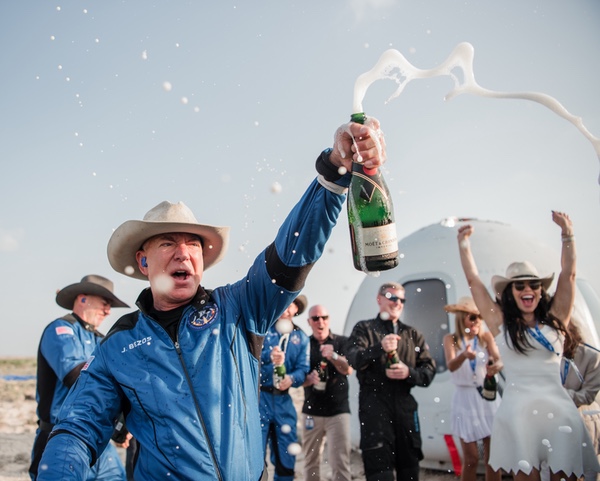Will suborbital space tourism take a suborbital trajectory?by Jeff Foust
|
| “My expectations were high, and they were dramatically exceeded,” Jeff Bezos said. |
The company, though, had little competition. Companies like Armadillo Aerospace, Rocketplane Global, and XCOR Aerospace went out of business long before they were ready to start flying people. Other XPRIZE competitors also faded away (remember The Da Vinci Project?) All that was left was Blue Origin, which had the financial wherewithal to continue development but which worked at a pace that was more gradatim than ferociter.
But like a person who waited for ages at a bus stop, only to have two buses show up at once, suborbital space tourism’s moment may have finally arrived thanks to both Blue Origin and Virgin Galactic. On July 11, it was Virgin Galactic that flew SpaceShipTwo with six people, including founder Richard Branson, on board, demonstrating what a commercial flight might be like (see “The suborbital spaceflight race isn’t over”, The Space Review, July 12, 2021).
Nine days later, it was Blue Origin’s turn. For the first time, the autonomously controlled New Shepard would have people on board for this mission, formally designated NS-16. Blue Origin founder Jeff Bezos was joined by his brother Mark, Wally Funk of “Mercury 13” fame, and Oliver Daemen, an 18-year-old Dutch person taking a year off before starting college. It also marked the first time that the company opened up its Launch Site One in the West Texas desert north of the small town of Van Horn to the media.
The flight itself looked a lot like the previous, uncrewed New Shepard flights. Taking off at about 9:12 a.m. EDT, the booster’s BE-3 engine performed as expected, sending the capsule called “RSS First Step” on a suborbital trajectory with an apogee of 107 kilometers. Ten minutes and ten seconds after liftoff, that capsule landed under parachutes, nearly three minutes after the booster made a powered landing on a nearby pad.
Bezos and the others on board appeared to enjoy every minute of the flight. Video released afterwards showed them floating around the cabin, enjoying the view, and even tossing Skittles candies during the few minutes of microgravity. (Skittles, either aware of this in advance or acting with remarkable speed afterwards, announced two days later plans to offer limited-edition “Zero-G Skittles” in special packaging.)
“My expectations were high, and they were dramatically exceeded,” Jeff Bezos said in a ceremony a couple hours after the flight at Launch Site One. (The event was billed to the media in attendance as a press conference lasting an hour, but ended after about 45 minutes, having taken only three questions from reporters.) Viewing the Earth from suborbital altitudes, he added, was “very profound.”
Mark Bezos and Daemen offered similar praise for the experience. Only Funk sounded a little disappointed, noting at that ceremony that the view out the window wasn’t as expansive as she expected, and suggesting the cabin was a little cramped. “There was not quite enough room for all four of us,” she said, notable since New Shepard is designed to carry six people.
She wasn’t complaining about the flight that much, though. “It was great. I loved it. I can hardly wait to go again.”
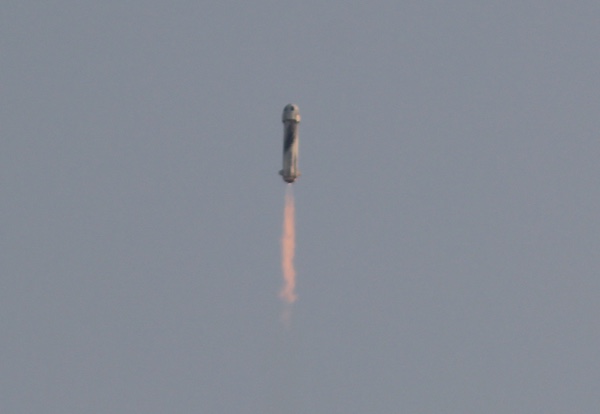 New Shepard ascends on its July 20 crewed flight. (credit: J. Foust) |
Building the suborbital business
Of the four people on New Shepard, Daemen was the least well known. Blue Origin announced he would fly just five days before the launch, as something of a last-minute replacement. The seat was to go to the winner of an auction that concluded June 12, with an unidentified individual making a winning bid of $28 million. That person, though, had a “scheduling conflict,” Blue Origin explained, but didn’t identify the person or the nature of the conflict. The company announced the July 20 date of the flight when it started the auction in early May.
The soft-spoken Daemen wasn’t a big presence both in pre-flight interviews the four did with major television networks before the launch or at the post-flight ceremony. “It felt way cooler than it looked,” he said at the ceremony.
He was noteworthy, though, for two things. At 18, he is now the youngest person to fly in space, breaking the record set by Gherman Titov in 1961 when he flew on the second Vostok mission a month before his 26th birthday.
| “Willingness to pay continues to be quite high. Our early flights are going for a very good price,” said Smith. “I think we’re seeing very strong interest.” |
Second, and arguably more importantly, he is the first commercial suborbital space traveler. Everyone who has flown on SpaceShipTwo have been company employees (or, in the case of Branson, the founder.) Jeff Bezos flew his brother and Funk as guests. Daemen, however, paid an unspecified amount for the flight—or, rather, his father, a private equity executive, paid the for the ticket.
Blue Origin has taken a different approach to selling seats than Virgin Galactic, which started selling tickets 15 years ago at $200,000, later increasing it to $250,000. Blue Origin hasn’t announced a ticket price or publicly started sales, instead taking the approach of private sales, starting with bidders from the auction.
“Since the auction that we held on June 12, I have had the pleasure of chatting with many of our future customers that have already signed up for the subsequent flights,” said Ariane Cornell, director of astronaut sales at Blue Origin, at a pre-launch media briefing July 18. “We have already built a robust pipeline of customers that are interested.”
The company hasn’t disclosed how many customers it’s signed up, or what prices they paid. “Willingness to pay continues to be quite high. Our early flights are going for a very good price,” said Bob Smith, CEO of Blue Origin, at that briefing. “I think we’re seeing very strong interest.”
At the post-flight ceremony, Bezos didn’t disclose how many people had signed up, but did reveal how much the company has raked in. “We’re approaching $100 million in private sales already, and the demand is very, very high,” he said.
Company officials said privately that they’re not trying to build a big backlog of customers because it would take time to fly them. Blue Origin expects to perform two more crewed suborbital flights this year, including at least one with six people on board. It will increase that flight rate next year, but by how much isn’t clear. “What we do in the following year I’m not sure yet. We’ll figure that out, and what the cadence will eventually be,” Bezos said.
Virgin Galactic has about 600 customers who have paid anywhere from a small deposit to the full value of their ticket. Those customers won’t start flying until next year, as Virgin Galactic plans just two more test flights of its current SpaceShipTwo, VSS Unity, before going into a maintenance period this fall. (One of those two flights will be for the Italian Air Force, producing about $2 million in revenue for the company.) That will take more than 100 flights to work through; while future SpaceshipIII vehicles will carry six in the cabin, Unity can accommodate only four. That’s a couple years even at the optimistic flight rate of one per week.
That may be why Virgin Galactic is not in a hurry to reopen ticket sales. While company executives previously said they would start selling tickets again after Branson’s flight, the only announcement they made after the July 11 launch was a contest to raffle off two seats on one of the first commercial flights next year, with the proceeds going to a nonprofit organization, Space for Humanity.
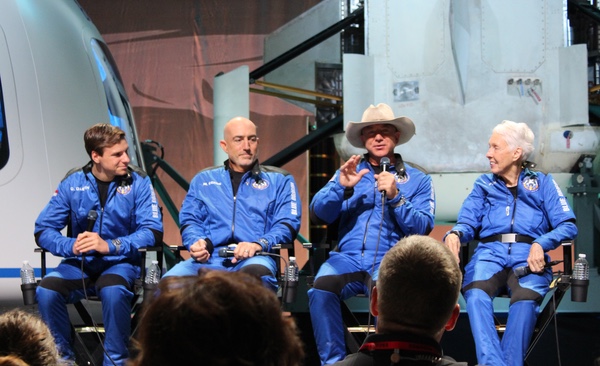 Jeff Bezos speaks at a post-flight ceremony along with (from left) Oliver Daemen, Mark Bezos, and Wally Funk. (credit: J. Foust) |
Surviving a backlash
When SpaceShipOne won the XPRIZE in 2004, there wasn’t much criticism of the role of the wealthy in backing the project. If one billionaire—Allen—wanted to bankroll a suborbital spaceplane and another—Branson—wanted to commercialize it, so be it.
Billionaires, though, have gotten even wealthier and, given growing discussion of income inequality, bigger targets. None is bigger than Bezos, whose net worth is now more than $200 billion, according to Forbes. How billionaires like Bezos accumulate and spend their wealth, or even that they have that wealth in the first place, became a theme of criticism throughout the coverage of the New Shepard flight.
| “Just as normal Americans pay taxes when they buy airline tickets, billionaires who fly into space to produce nothing of scientific value should do the same, and then some,” Blumenauer said. |
Bezos didn’t help matters much at the post-flight ceremony, at least at first. After thanking the employees of Blue Origin for building New Shepard, he said, “I want to thank every Amazon employee and every Amazon customer, because you guys paid for all this.” While true—Bezos bankrolled Blue Origin thanks to his stake in Amazon—it came off as tone-deaf to many, and factored into the criticism of Bezos, Blue Origin, and commercial spaceflight that followed.
Perhaps anticipating that criticism, Bezos used part of the ceremony for something unrelated to Blue Origin. He announced a new “Courage and Civility Award” he was funding, giving the first two to activist and political commentator Van Jones and to chef and humanitarian José Andrés. Each received $100 million.
Even before Bezos took the stage, though, one member of Congress was weighing in on suborbital space tourism. Moments after New Shepard safely landed, Rep. Earl Blumenauer (D-OR), a member of the House Ways and Means Committee, announced he would introduce legislation to tax suborbital or orbital spaceflights.
“Space exploration isn’t a tax-free holiday for the wealthy. Just as normal Americans pay taxes when they buy airline tickets, billionaires who fly into space to produce nothing of scientific value should do the same, and then some,” he said in a statement.
His Securing Protections Against Carbon Emissions (SPACE) Tax Act¬—yet to be introduced—would levy per-person taxes on commercial flights with no scientific purpose. (He didn’t disclose what would constitute scientific research.) One tax rate would go towards suborbital flights while a second, “significantly higher” rate would be applied to orbital flights.
“I’m not opposed to this type of space innovation,” he said of commercial spaceflight. “However, things that are done purely for tourism or entertainment, and that don't have a scientific purpose, should in turn support the public good.”
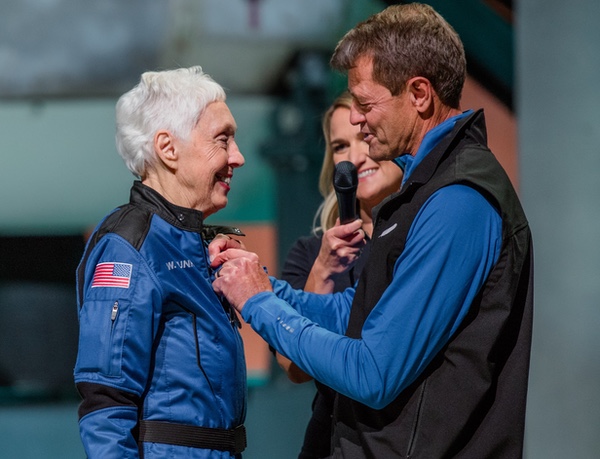 Wally Funk received Blue Origin’s own astronaut pin from Jeff Ashby, a former NASA astronaut. (credit: Blue Origin) |
Clipped wings
The same day that New Shepard carried people for the first time, the FAA weighed in on who would be eligible for commercial astronaut wings that the agency awards.
The FAA started awarding those wings in 2004, when SpaceShipOne pilots Mike Melvill and Brian Binnie received them for their suborbital flights. It wasn’t until 2019, though, when the agency awarded the next wings: Mark Stucky and CJ Sturckow received them for the first SpaceShipTwo flight beyond 80 kilometers (Sturckow, a former NASA astronaut, had NASA wings from his four shuttle missions), while David Mackay, Mike Masucci, and Beth Moses received them for being on the second flight. All were pilots except for Moses, who conducted tests of the SpaceShipTwo cabin interior.
| “The FAA has now changed the focus [of its astronaut wings] to recognize flight crew who demonstrate activities during flight that were essential to public safety, or contributed to human space flight safety, among other criteria,” the agency said. |
All appeared to fit the original criteria the FAA established for those wings: be considered part of the crew of the vehicle as defined in federal regulations and go to an altitude of at least 50 miles (about 80 kilometers). In the July 20 update, though, the FAA added a third: “Demonstrated activities during flight that were essential to public safety, or contributed to human space flight safety.”
“When the program was first created in 2004, its focus was to recognize flight crew members who furthered the FAA’s mission to promote the safety of vehicles designed to carry humans,” the FAA said in a statement. “The FAA has now changed the focus to recognize flight crew who demonstrate activities during flight that were essential to public safety, or contributed to human space flight safety, among other criteria.”
That appeared to exclude some of the people on the recent flights. Was Branson, who flew on SpaceShipTwo to evaluate the “experience” of the flight, performing work related to public safety or human space flight safety? And what about those on New Shepard?
Some, concluding that neither Bezos nor Branson would quality under the new rules, declared in news reports that they would not become astronauts; coverage tinged with a degree of schadenfreude, perhaps. Reality is a little more complex.
First, even under the old rules, it’s not clear anyone who flew on New Shepard would qualify as crew under FAA regulations. None of them were flying the vehicle, which was controlled from the ground. “This is an autonomous vehicle. There’s really nothing for a crew member to go do,” Blue Origin’s Smith said at the pre-launch briefing.
Second, the FAA order doesn’t define the term “astronaut” at all. It instead lays out the conditions for which it awards “astronaut wings,” and the term “astronaut” is not defined in the law. (“Government astronaut” is, as part of a 2015 fix to federal law to address issues about government employees flying on commercial vehicles.) Some members of NASA’s astronaut corps, for example, don’t have NASA astronaut wings since they have not yet flown in space, but few would not consider them astronauts.
Most importantly, though, the revised rules make it more likely people like Bezos and Branson get astronaut wings. The revised rules give the FAA the ability to award “honorary” commercial astronaut wings to “individuals who demonstrated extraordinary contribution or beneficial service to the commercial human space flight industry” but don’t meet the official criteria.
That would allow the FAA, if it so desired, to give wings to everyone on both the SpaceShipTwo and New Shepard flights, given their historic nature. And it would avoid the outrage that might erupt if the FAA concluded that, under the old rules, Wally Funk wouldn’t be eligible for astronaut wings 60 years after being denied the chance to become a NASA astronaut. Crisis averted!
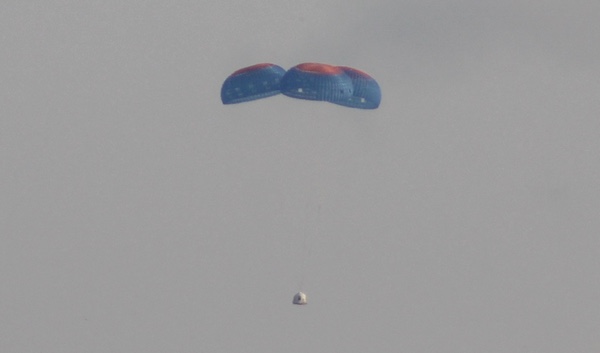 The New Shepard crew capsule descends under parachutes shortly before landing. (credit: J. Foust) |
Diverging paths
Blue Origin and Virgin Galactic reached the starting line of commercial suborbital human spaceflight at about the same time but took very different paths to get there. Moreover, they’re heading in very different directions.
Virgin Galactic is betting its future on growing demand for suborbital human spaceflight. Its financial projections foresee a rapidly increasing flight rate, supported by development of new vehicles and new spaceports. The company has talked about leveraging that technology for high-speed point-to-point transportation, but that is likely many years in the future, and not achievable at all unless suborbital tourism proves to be as profitable as it foresees.
| “What you see behind me is basically the second stage of New Glenn,” Bezos said. “So, every time we fly this tourism mission, we’re practicing flying the second stage of New Glenn.” |
For Blue Origin, though, suborbital is only a step. The company has talked about how it’s used the experience developing New Shepard for its New Glenn orbital vehicle and other projects. (Bezos, at post-flight ceremony, even mentioned New Armstrong, the even larger orbital vehicle the company has mentioned in the past but about which it’s disclosed no details.)
“You would never choose liquid hydrogen for a suborbital tourism vehicle,” Bezos said of the fuel that powers the BE-3 engine on New Shepard. He then pointed to a New Shepard propulsion module, towering over the audience. “What you see behind me is basically the second stage of New Glenn. So, every time we fly this tourism mission, we’re practicing flying the second stage of New Glenn.”
And while that tourism mission may initially be lucrative, one can see a future where, if demand drops off to the point where it’s not profitable, or simply too much trouble, Blue Origin may pull the plug on New Shepard. Presumably they’ll have enough experiencing flying it to support New Glenn (whose current issues, like delays in development of the BE-4 engine, have little relationship to New Shepard.)
As noted here previously (see “Is a billionaire space race good for the industry?”, The Space Review, June 14, 2021), suborbital space tourism was once touted, back in the days of the Ansari XPRIZE, as the key to unlocking low-cost reusable space transportation by tapping the one market big enough to support the development of such vehicles. The combination of smallsats and SpaceX offered an alternative path that most of the industry has largely followed.
The era of commercial suborbital human spaceflight may finally be here, but whether it lasts isn’t certain, and neither is its importance.
Note: we are using a new commenting system, which may require you to create a new account.
